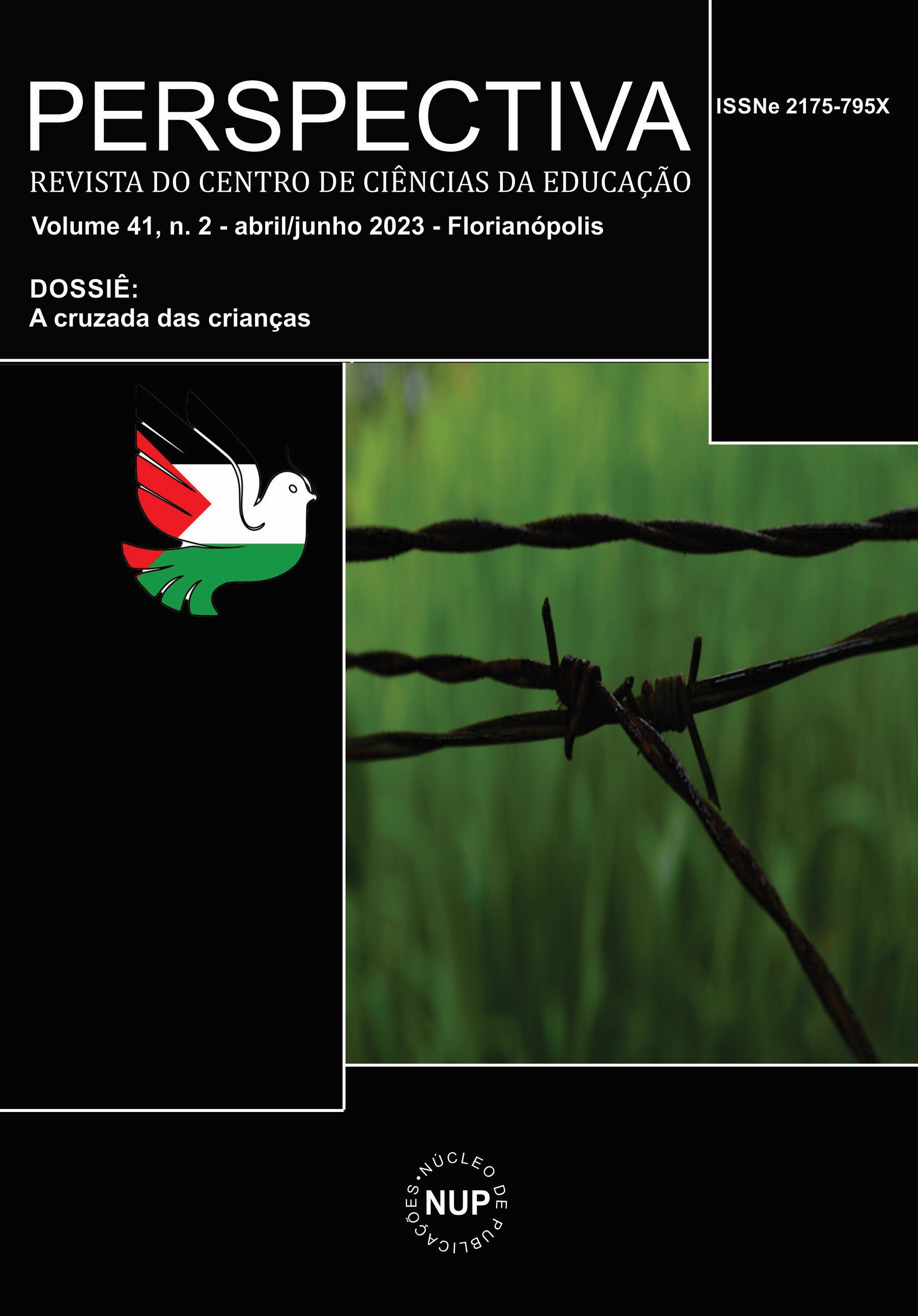Crianças Mangues, Crianças Praças e Crianças Ruas: Quando as paisagens se fazem em corpos infantis: espaços albergues para (algumas) infâncias. Contribuições da Geografia da Infância aos deslocamentos forçados infantis
DOI:
https://doi.org/10.5007/2175-795X.2023.e86466Palavras-chave:
Infâncias em deslocamentos, Linguagem Espacial, Vivência EspacialResumo
Este artigo tem por objetivo refletir sobre as variadas infâncias que habitam este planeta e suas relações com o espaço em que vivem. Parte do reconhecimento de que o espaço é uma importante linguagem e que apresenta estreitas relações com a formação humana, incluindo, aí, os bebês e as crianças. O espaço se expressa de variadas formas na vida, em paisagens, em territórios, em lugares. Todas essas dimensões apresentam relações axiológicas que estão nas fronteiras do ser humano e de seu desenvolvimento. Nessa perspectiva, há uma gramática espacial a ser considerada no existir e em todas as situações que envolvem o viver em sociedade. Pautado nos estudos da Geografia da Infância, nosso desejo é contribuir, em especial, com o olhar sobre as crianças em movimentos, em deslocamentos forçados. Uma situação que se debruça sobre as muitas infâncias no mundo contemporâneo e nos diferentes territórios que vivem. Para isso, iniciamos nossa reflexão com o conceito criado pelos autores da Teoria Histórico-cultural: o de vivência (perijvanie) e dele desdobramos para o conceito de vivência espacial (prostranstvennoe perejivanie), em um segundo momento, dialogamos com as narrativas espaciais de algumas crianças, em especial, as crianças que vivem nas ruas da cidade de Nova Déli, India, tendo por base pesquisas feitas em anos anteriores, sistematizadas em forma de texto acadêmico. Finalizamos reafirmando a importância de se considerar o espaço nessa vivência. Além dos teóricos e dos dados de campo, o texto é escrito tendo como fio condutor o diálogo com Josué de Castro e sua importante obra “Homens e Caranguejos”.
Referências
BAKHTIN. M. Questões de Literatura e Estética. A teoria do Romance. São Paulo: Hucitec, 2014.
CASTRO, J. de. Homens e Caranguejos. São Paulo: Brasiliense, 1967.
ENNEW, J. Street and Working Children: A guide to planning. Save the Children: London, 1994.
FREIRE, P. Educadores de rua – uma abordagem crítica. Alternativas de atendimento aos meninos de rua. Bogotá: Unicef. 1989.
KAPOOR, A. Role of Voluntary orgnisations in the lives of street children. Masters Dissertation, University of Delhi: New Delhi, 2010.
KRAVTSOV, G. As bases filosóficas da psicologia histórico-cultural. VERESK – Cadernos Acadêmicos Internacionais. Estudos sobre a perspectiva histórico-cultural de Vigotski. Brasília: UniCEUB, 2014.
LOPES, J. J. M. Então somos Mudantes: Espaço, Lugar e identidade em crianças migrantes. Tese de Doutorado. 2003. Niterói. Faculdade de Educação. Universidade Federal Fluminense. 2003.
LOPES, J. J. M. Terreno Baldio- um livro sobre balbuciar e criançar os espaços para desacostumar geografias. Por uma teoria sobre a espacialização da vida de bebês e crianças. São Carlos: Pedro e João, 2021.
MANIHARA, S. Street Children: An International Problem. In: My Name is Today: A Dossier on Children and Children’s Rights. Children and Development Issues, vol II, p. 343-46, 2003.
MCFADYEN, L. Voices from the street: An ethnography of India’s street children. New Delhi: Hope India Publications, 2004.
MUKHOPADHYAY, B. Crossing the Howrah Bridge: Calcutta, Filth and Dwelling Forms, Fragments, Phantasms. Theory Culture Society, nº 23, p. 221, Sage Publications, 2006.
PANDEY, R. Street Children of India: A situational Analysis. Chugh Publications: Allahabad-India, 1991.
PANTER-BRICK, C. Nobody’s Children? A reconsideration of child abandonment. In Panter- Brick, C.; SMITH, M.T. (Eds.). Abandoned Children. Cambridge: Cambridge University Press, 2000. p. 1-26.
ROBINSON, M. Privatizing the Voluntary Sector: NGOs as Public Service Contractors. In HULME, D.; EDWARDS, M. (Eds.). In NGOs, States and Donors: Too Close for Comfort? New York: St. Martin's Press, 1997.
SANTOS, M. A Natureza do Espaço: Técnica, Razão e Emoção. São Paulo: Edusp, 2003
SILVA, H.; MILITO, C. Vozes do Meio Fio. Rio de Janeiro: Editora Relume & Dumará, 1995.
SONDHI-GARG, P. Street Children: Lives of Valor & Vulnerability. New Delhi: Reference Press, 2004.
VIGTOSKI, L. S. Sete aulas de Pedologia. Rio de Janeiro: Epapers, 2018.
VIGOTSKI, L. S. Obras escogidas. Tomo IV. Madrid: Visor y A. Machado Libros, 2006.
Publicado
Como Citar
Edição
Seção
Licença
Copyright (c) 2023 Jader Janer Moreira Lopes, Ambika Kapoor

Este trabalho está licenciado sob uma licença Creative Commons Attribution 4.0 International License.
Esta revista proporciona acesso público a todo seu conteúdo, seguindo o princípio de que tornar gratuito o acesso a pesquisas gera um maior intercâmbio global de conhecimento. Tal acesso está associado a um crescimento da leitura e citação do trabalho de um autor. Para maiores informações sobre esta abordagem, visite Public Knowledge Project, projeto que desenvolveu este sistema para melhorar a qualidade acadêmica e pública da pesquisa, distribuindo o Open Journal Sistem (OJS) assim como outros software de apoio ao sistema de publicação de acesso público a fontes acadêmicas. Os nomes e endereços de e-mail neste site serão usados exclusivamente para os propósitos da revista, não estando disponíveis para outros fins.
A Perspectiva permite que os autores retenham os direitos autorais sem restrições bem como os direitos de publicação. Caso o texto venha a ser publicado posteriormente em outro veículo, solicita-se aos autores informar que o mesmo foi originalmente publicado como artigo na revista Perspectiva, bem como citar as referências bibliográficas completas dessa publicação.



